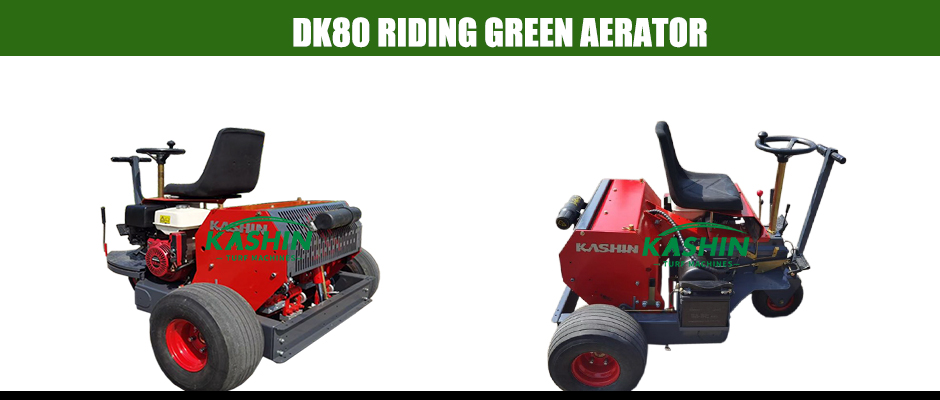Spring in May is the best season for most golf courses in China. The withered warm-season lawns wake up from hibernation, and the bent grass is full of vitality, providing the most ideal greens. For golf enthusiasts, the suitable temperature, warm sunshine, green golf courses, and especially the smooth and fast greens are all the best time to hit the ball. But one day, when the excited golfers came to the greens, they suddenly found that the greens that were still smooth yesterday had been drilled and were completely unrecognizable. They often asked why the good greens needed to be drilled. Sometimes even the club’s boss kept asking the turf director whether he could skip the drilling operation or postpone the drilling time. Indeed, nothing can make guests feel more disgusted than drilling holes, but to gain the understanding of guests, they must understand why drilling holes is needed.
First of all, drilling holes helps water penetrate the soil faster. The lawn forms a dense canopy on the surface of the green, and the dead grass layer on the surface will hinder water from entering the soil. And as the soil becomes more compacted, it is even more difficult for water to enter. In severe cases, “dry spots” will form, and no matter how much water is applied, the dry spots cannot penetrate into the soil. Sometimes turf directors use penetrants to deal with dry spots. Of course, penetrants are also effective, but drilling is the most economical and effective. The drilling needle directly penetrates the turf and the dead grass layer, forming a channel for water to enter the soil. At the same time, it also creates conditions for the entry of oxygen. Plant roots need to breathe enough oxygen to ensure the normal physiological metabolism of plants.

Secondly, for green maintenance, controlling the dead grass layer (or organic matter) in the soil is crucial to ensure the growth of the lawn. The roots of the lawn are constantly growing, dying, and growing again in the sand. These dead roots remain in the gaps in the sand, waiting for microorganisms to decompose them into minerals, which are then reabsorbed and utilized by plants. However, it takes a certain amount of time for these dead roots to decompose, and those that do not have time to decompose become organic matter in the sand. These organic matter are like sponges, which can absorb several times their own water. A certain amount of organic matter is necessary for sandy lawn beds, which helps to retain water and fertilizer. However, when the content reaches a certain level, it will have a negative impact on the growth of the lawn, such as more diseases, easy to “graze”, soft and fluffy greens, which is particularly harmful in hot and rainy summers, and can easily lead to poor growth or even death of bentgrass. In order to remove organic matter from the soil, turf directors generally make hollow holes, cut roots and frequently spread thin sand. Among them, making hollow holes is an important part that cannot be ignored. Solid holes can reduce organic matter by improving the air permeability of the soil and accelerating the decomposition of organic matter, while hollow holes can also bring out some sand with high organic matter content, and “dilute” the original organic matter content by spreading new sand into the hole. The key to making hollow holes is to fill the hole with new sand, otherwise it will not achieve the desired effect of reducing the organic matter content, just like pouring out half of a bottle of wine, and the alcohol content of the remaining half of the bottle remains unchanged. Only when half of the water is added, the alcohol concentration will decrease. The larger the hole diameter, the smaller the hole spacing, and the more frequent the drilling, the better the effect of controlling organic matter. However, in reality, it is sufficient to control organic matter within a certain range, generally 1-3%.
Reducing the impact of drilling is also an issue that the turf director needs to consider. Try to choose Monday as the drilling time, when there are the least guests and the operation is more convenient. And try to choose the season when the lawn grows most vigorously, so that the lawn recovers fastest. Soil temperature is one of the biggest factors affecting lawn growth. Therefore, the drilling time for warm-season lawns is selected in summer, while the drilling time for cool-season lawns is selected in spring and autumn. At the same time, try to fill the gaps with sand. Sometimes, in order to fill the gaps with sand, workers use trawls to drag sand repeatedly, which can cause serious damage to delicate green grass, especially cool-season green grass, and greatly delay the recovery time of drilling. It is recommended to use a hair dryer to blow sand or use a carpet to drag sand, which will cause much less damage.
It is also a good way to use a certain amount of nitrogen fertilizer to promote lawn growth before drilling. Use 3-5 grams of pure nitrogen per square meter. It is best to apply fertilizer one week before aeration, because it takes 5-7 days for the fertilizer to be absorbed and converted by the lawn. In this way, the lawn will just grow vigorously with the help of fertilizer by the time of aeration. You can also spray foliar fertilizer once or twice after aeration to help recovery.
Aeration is very important for maintaining the healthy growth of the green. The turf director must make the guests understand that aeration is to obtain a continuously healthy green. For long-term health, short-term inconveniences should be tolerated. Gradually, guests will see the continuous benefits brought by aeration and understand the operation of aeration.
Post time: Nov-15-2024
